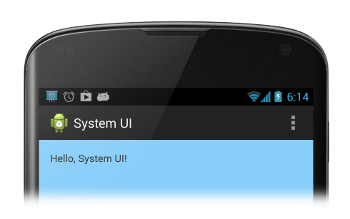This lesson describes how to hide the status bar on different versions of Android. Hiding the status bar (and optionally, the navigation bar) lets the content use more of the display space, thereby providing a more immersive user experience.
Figure 1 shows an app with a visible status bar:

Figure 1. Visible status bar.
Figure 2 shows an app with a hidden status bar. Note that the action bar is hidden too. You should never show the action bar without the status bar.

Figure 2. Hidden status bar.
Hide the Status Bar on Android 4.0 and Lower
You can hide the status bar on Android 4.0 (API level 14) and lower by setting
WindowManager flags. You can do this programmatically or by
setting an activity theme in your app's manifest file. Setting an activity theme in your app's
manifest file is the preferred approach if the status bar should always remain
hidden in your app (though strictly speaking, you could programmatically override the
theme if you wanted to). For example:
<application ... android:theme="@android:style/Theme.Holo.NoActionBar.Fullscreen" > ... </application>
The advantages of using an activity theme are as follows:
- It's easier to maintain and less error-prone than setting a flag programmatically.
- It results in smoother UI transitions, because the system has the information it needs to render your UI before instantiating your app's main activity.
Alternatively, you can programmatically set WindowManager flags.
This approach makes it easier to hide and show the status bar as the user interacts with
your app:
Kotlin
class MainActivity : Activity() { override fun onCreate(savedInstanceState: Bundle?) { super.onCreate(savedInstanceState) // If the Android version is lower than Jellybean, use this call to hide // the status bar. if (Build.VERSION.SDK_INT < 16) { window.setFlags(WindowManager.LayoutParams.FLAG_FULLSCREEN, WindowManager.LayoutParams.FLAG_FULLSCREEN) } setContentView(R.layout.activity_main) } ... }
Java
public class MainActivity extends Activity { @Override protected void onCreate(Bundle savedInstanceState) { super.onCreate(savedInstanceState); // If the Android version is lower than Jellybean, use this call to hide // the status bar. if (Build.VERSION.SDK_INT < 16) { getWindow().setFlags(WindowManager.LayoutParams.FLAG_FULLSCREEN, WindowManager.LayoutParams.FLAG_FULLSCREEN); } setContentView(R.layout.activity_main); } ... }
When you set WindowManager flags (whether through an activity theme or
programmatically), the flags remain in effect unless your app clears them.
You can use
FLAG_LAYOUT_IN_SCREEN
to set your activity layout to use the same screen area that's available when you've enabled
FLAG_FULLSCREEN. This prevents your
content from resizing when the status bar hides and shows.
Hide the Status Bar on Android 4.1 and Higher
You can hide the status bar on Android 4.1 (API level 16) and higher by
using setSystemUiVisibility().
setSystemUiVisibility() sets UI flags at
the individual view level; these settings are aggregated to the window level. Using
setSystemUiVisibility() to set UI flags
gives you more granular control over the system bars than using
WindowManager flags. This snippet hides the status bar:
Kotlin
// Hide the status bar. window.decorView.systemUiVisibility = View.SYSTEM_UI_FLAG_FULLSCREEN // Remember that you should never show the action bar if the // status bar is hidden, so hide that too if necessary. actionBar?.hide()
Java
View decorView = getWindow().getDecorView(); // Hide the status bar. int uiOptions = View.SYSTEM_UI_FLAG_FULLSCREEN; decorView.setSystemUiVisibility(uiOptions); // Remember that you should never show the action bar if the // status bar is hidden, so hide that too if necessary. ActionBar actionBar = getActionBar(); actionBar.hide();
Note the following:
- Once UI flags have been cleared (for example, by navigating away from the activity), your app needs to reset them if you want to hide the bars again. See Responding to UI Visibility Changes for a discussion of how to listen for UI visibility changes so that your app can respond accordingly.
- Where you set the UI flags makes a difference. If you hide the system bars in your activity's
onCreate()method and the user presses Home, the system bars will reappear. When the user reopens the activity,onCreate()won't get called, so the system bars will remain visible. If you want system UI changes to persist as the user navigates in and out of your activity, set UI flags inonResume()oronWindowFocusChanged(). - The method
setSystemUiVisibility()only has an effect if the view you call it from is visible. - Navigating away from the view causes flags
set with
setSystemUiVisibility()to be cleared.
Make Content Appear Behind the Status Bar
On Android 4.1 and higher, you can set your application's content to appear behind
the status bar, so that the content doesn't resize as the status bar hides and shows.
To do this, use
SYSTEM_UI_FLAG_LAYOUT_FULLSCREEN.
You may also need to use
SYSTEM_UI_FLAG_LAYOUT_STABLE to help your app maintain a
stable layout.
When you use this approach, it becomes your responsibility to ensure that critical parts
of your app's UI (for example, the built-in controls in a Maps application) don't end up
getting covered by system bars. This could make your app unusable. In most cases you can
handle this by adding the android:fitsSystemWindows attribute to your XML layout file, set to
true. This adjusts the padding of the parent ViewGroup
to leave space for the system windows. This is sufficient for most applications.
In some cases, however, you may need to modify the default padding to get the desired
layout for your app. To directly manipulate how your
content lays out relative to the system bars (which occupy a space known as the window's
"content insets"), override fitSystemWindows(Rect insets).
The fitSystemWindows() method is called by the
view hierarchy when the content insets for a window have changed, to allow the window to
adjust its content accordingly. By overriding this method you can handle the
insets (and hence your app's layout) however you want.
